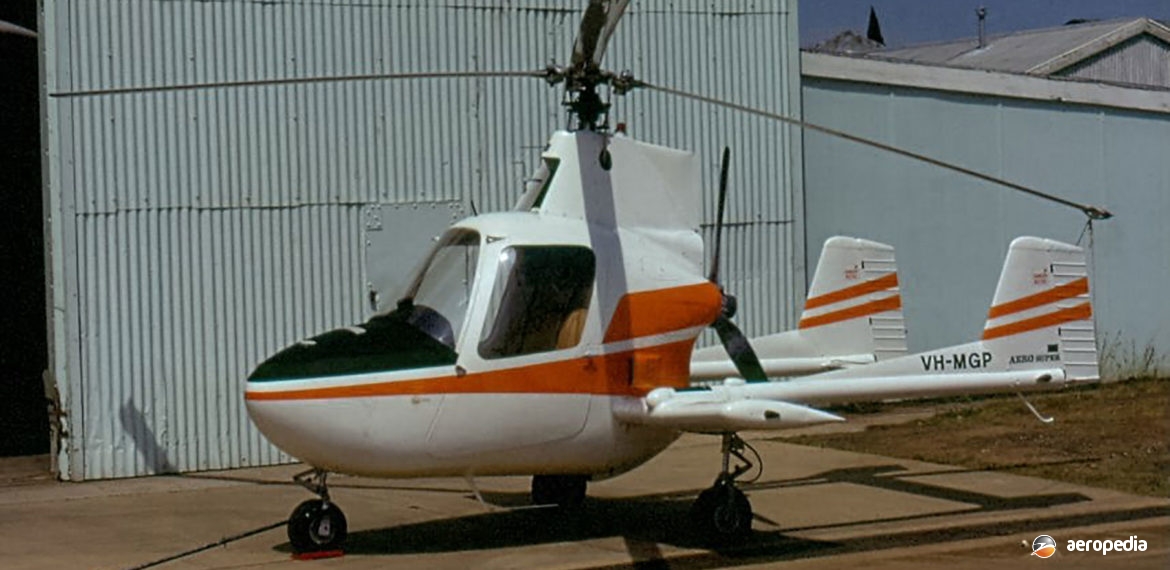Photograph:
McCulloch J-2 VH-MGP (c/n 086) at Bankstown, NSW in November 1973 (David C Eyre)
Country of origin:
United States of America
Description:
Two-seat light sport autogyro
Power Plant:
One 134 kw (180 hp) Lycoming O-360-A2D four-cylinder horizontally-opposed air-cooled engine
Specifications:
- Rotor diameter: 7.92 m (26 ft)
- Length: 4.88 m (16 ft)
- Height: 2.51 m (8 ft 3 in)
- Wingspan: 3.4 m (11 ft 2 in)
- Max permissible diving speed: 225 km/h (140 mph)
- Cruising speed: 193 km/h (120 mph)
- Landing and take-off speed 0 to: 48 km/h (0 to 30 mph)
- Rate of climb at sea level: 305 m/min (1,000 ft/min)
- Service ceiling: 3,950 m (13,000 ft)
- Range with max fuel and reserves: 480 km (300 miles)
- Empty weight: 408 kg (900 lb)
- Loaded weight: 657 kg (1,450 lb)
History:
The McCulloch J-2 was a two-seat, side-by-side, light autogyro, the prototype of which was flown for the first time in June 1962. At first the type was known as the Jovair J-2, and was built by the Jovair Corporation at El Segundo in California, having been designed by Drago Jovanovich. The Company had been formed to design, test and produce light rotating-wing aircraft and the prototype for a period was known as the Jovanovich Jov-2. In addition to the J-2, it developed and produced a four-seat, tandem rotor, light helicopter known as the Sedan 4E. Jovair became involved in the production of the Sedan, so McCulloch Motors, which had a helicopter division, took over production of the J-2. Like the Sedan, the J-2 was designed by Mr D K Jovanovich. Subsequently the Sedan 4E became known as the McCulloch 4E.
The J-2 had a three-blade rotor with fully articulated blades built up of aluminium extrusion and wrap-around skin, bonded together to form fail-safe structures, which were interchangeable. In addition, it was fitted with short, mid-set cantilever wings, carrying tail-booms and the main undercarriage. The fuselage was an aluminium chassis-type structure, and the tail unit was a cantilever all-metal structure with twin fins and rudders carried on the tail-booms. Accommodation was provided for two side-by-side in an enclosed cabin with a forward-hinged door on each side. An enclosed baggage compartment was in the nose, and further baggage space was available under the seats.
The type was imported and marketed in Australia by Hawker de Havilland at Bankstown, NSW and one example was fitted with an extra fuel tank and taken to the Northern Territory where it was shown to sheep and cattle station personnel with a view to the type being used in the mustering role. However, the type suffered from a noisy cockpit and the manufacturers made a number of attempts to reduce this, including the installation of a 149 kw (200 hp) engine and a three-blade constant speed Hartzell propeller. Also, it is said it did not have the desired performance and had limited range on the fuel available.
A small number of J-2 gyrocopters were imported to Australasia. Marketed as the Aero Resources J-2, they were assembled in the Hawker Siddeley hangar at Bankstown, NSW in 1973 and 1974. These included: VH-BFS (c/n 068) withdrawn from service on 20 October 1982: VH-BGB (c/n 080) which crashed at Coldstream, VIC on 21 August 1977; VH-EYK (c/n 085) damaged at Budgerygar Station near Quilpie, QLD on 27 March 1976; VH-MGF (c/n 096) withdrawn from service on 13 July 1977; and VH-MGP (c/n 086). Two are known to survive. One example was registered in New Zealand in November 1999, becoming ZK-RCK (c/n 073 – ex N4363G).

